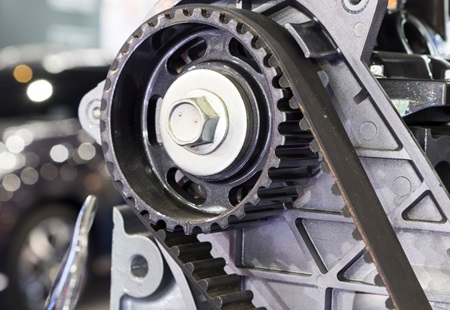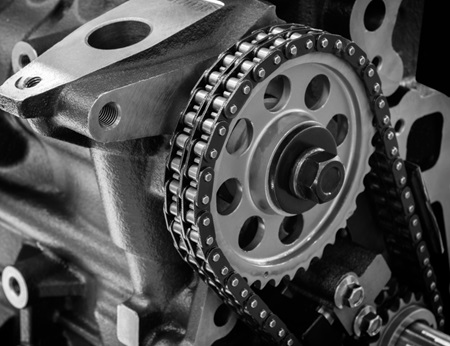Have you ever found yourself scratching your head over the mysterious world of timing chains and timing belts? Well, fear not, because we’re about to dive into the nitty-gritty of these crucial engine components. In the automotive universe, timing chains and timing belts play a pivotal role in synchronizing the dance of your engine’s internals. But what sets them apart? Why does it matter whether your ride sports a chain or a belt under the hood? Buckle up as we unravel the mystery, exploring the differences, advantages, and quirks of timing chains versus timing belts. So, whether you’re a DIY enthusiast, a curious car owner, or just someone who enjoys the inner workings of machines, this is the article for you. Let’s rev up and demystify the engine timing conundrum!
Outline
ToggleWhat is a Timing Belt?

What is a Timing Chain?

Timing Chains Vs Timing Belts – What’s the Difference?
1. Material Composition
- Timing Chains: Typically made of metal, often steel. Composed of interlocking links, similar to a bicycle chain.
- Timing Belts: Usually constructed from rubber reinforced with fibers such as fiberglass or Kevlar, featuring a toothed or ribbed surface for grip.
2. Durability and Longevity
- Timing Chains: Known for durability and longevity. They are less prone to wear and can last the lifetime of the engine under normal conditions.
- Timing Belts: Have a finite lifespan and require periodic replacement, usually recommended every 60,000 to 100,000 miles, to prevent potential failure.
3. Noise Levels
- Timing Chains: Generally produce more noise compared to timing belts. The metallic components can create audible sounds during operation.
- Timing Belts: Tend to be quieter in operation, contributing to a smoother and quieter engine performance.
4. Maintenance
- Timing Chains: Require less maintenance as they are designed to last longer. Regular oil changes are crucial to ensure proper lubrication.
- Timing Belts: Demand more frequent maintenance, and replacement is essential to prevent the risk of engine damage due to belt failure.
5. Cost of Replacement
- Timing Chains: Replacement can be more expensive due to the complexity of the repair process, involving more labor and potential engine disassembly.
- Timing Belts: Generally, replacement is more straightforward, but costs can vary depending on the make and model of the vehicle.
6. Performance in High-Stress Conditions
- Timing Chains: Tend to perform better in high-stress conditions and higher horsepower engines due to their robust metal construction.
- Timing Belts: May be more prone to stretching or breaking under high-stress conditions, making timing chains preferable for high-performance applications.
7. Design and Construction
- Timing Chains: Typically enclosed and bathed in engine oil, providing lubrication and cooling, contributing to their durability.
- Timing Belts: Exposed and operated dry, making them more susceptible to wear and degradation over time.
In summary, the choice between a timing chain and a timing belt depends on various factors, including the vehicle’s make and model, the owner’s maintenance preferences, and the engine’s specific requirements. Each component comes with its own set of advantages and considerations, influencing its suitability for different automotive applications.
What Happens When a Timing Belt or Timing Chain Breaks?
1. Timing Belt Breakage
- Risk of severe engine damage due to misalignment of camshaft and crankshaft.
- Engine valves may collide with pistons, causing bending or breakage.
- Complete engine failure, requiring extensive repairs or replacement.
2. Timing Chain Breakage
- Potential for engine damage, but generally less severe compared to a timing belt.
- Some engines are designed with safeguards to prevent catastrophic failure.
- Repair involves replacing the timing chain, and in some cases, addressing associated components.
Timing Chains Vs Timing Belts – FAQs
Ans: The cost to replace a timing chain varies widely, ranging from $500 to $2,500 or more. Factors influencing the expense include the vehicle make and model, labor costs, and whether other components like tensioners or guides need replacement during the process.
Ans: Timing belts generally last between 60,000 to 100,000 miles, depending on the manufacturer’s recommendations. In contrast, timing chains are more durable and can last the lifetime of the engine under normal driving conditions. Regular maintenance, such as oil changes, plays a crucial role in prolonging the lifespan of both components.
Conclusion
We’ve taken a thrilling ride through the world of timing chains and timing belts, uncovering the intricacies that make each tick (or click, in the case of the chain). Whether your engine rocks a chain or a belt, each has its own unique set of perks and quirks. Timing chains boast durability and longevity, marching to the beat of an engine’s lifetime, but they can be a bit noisier. On the flip side, timing belts bring a quieter performance but demand a timely replacement dance to keep the engine humming smoothly. It’s a symphony of engineering choices, each with its own tune in the grand symphony of the automotive world. So, next time you pop the hood, take a moment to appreciate the unsung heroes that keep your engine’s heartbeat in perfect rhythm—whether it’s the metallic melody of a timing chain or the rubbery harmony of a timing belt.

